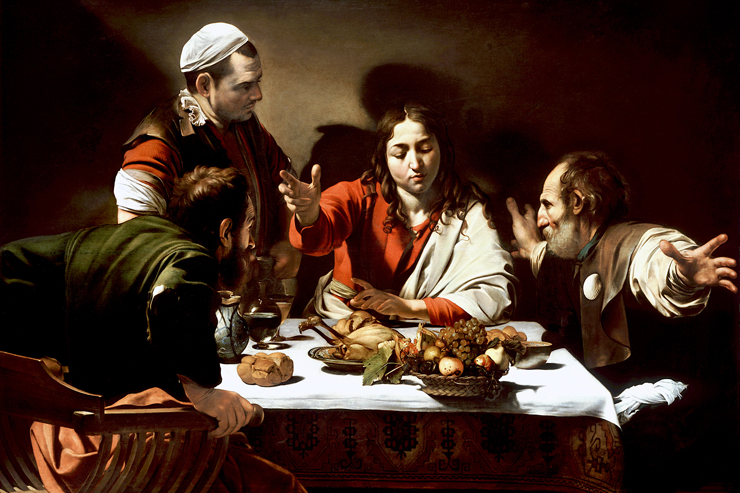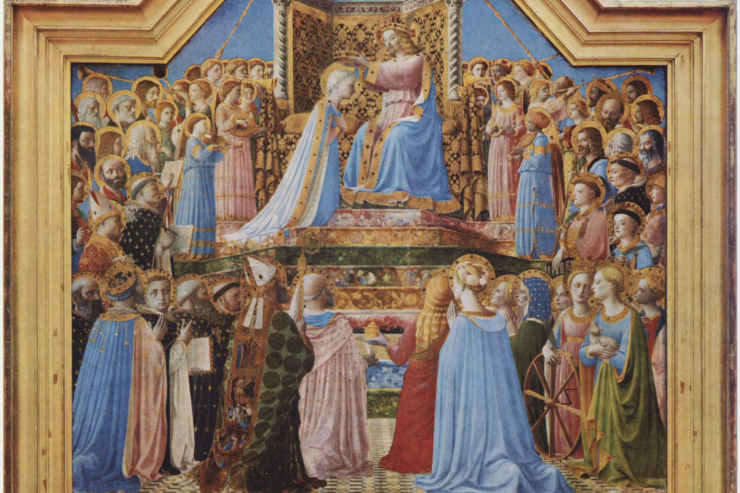The Three Ages of History centered on Christ Incarnate
Jesus Christ our Savior is the Lord of all creation! We in the Catholic Church “believe that the key, the center and the purpose of the whole of man’s history is to be found in its Lord and Master.”1 The incarnation of the second person of the Trinity signals the greatest event in all of Salvation History.
There are three stages that begin with the Creation and the historical narrative spanning across the ages of the Old Testament. (The age of the Father) It is enriched by prophecy and populated by typological events and characters prefiguring the Advent of the Christ and the life of the world to come. The second stage is the advent of the Redeemer who came to conquer sin and death. (The age of the Son) By His life death and resurrection, Christ came to restore us to the graces of the heavenly Kingdom. After His earthly sojourn, Christ ascended into Heaven and was seated at the right hand of the Father. The Holy Spirit descended upon the Apostles like tongues of fire. (The age of the Spirit) Pentecost is the birthday of Holy Mother Church and ushers in the third stage, the age of the Church. This stage will be brought to fruition in the fullness of time by the participation in the sacramental economy until the second coming. At the end of time the faithful will join in the Wedding feast of the Lamb in the Eternal Liturgy.
The framework for our present catechetical topic of exposition is no less than the entirety of the history of time and space and everything that lies in between. To begin to understand the nature of the divine economy we have to begin in the beginning, much like The Apostle John did in his inspired Gospel when he imparts that “In the beginning was the Word, and the Word was with God, and the Word was God.”2 The second person of the Blessed Trinity was there before time began and it was through Him that all things were made. “In him was life, and the life was the light of men. The light shines in the darkness, and the darkness has not overcome it.”3 Christ is the light of life and it is by this light that the darkness is banished from the land of the living. The light of Christ shines on the deepest mysteries and elucidates the face of God for those who strive by faithful mystagogy to purify their hearts. However, the mystagogical journey has been difficult lately.
The Catechetical Crisis’ Impact on Mystagogy
Catechesis in the Roman Catholic Church has suffered a certain kind of reductionism running roughshod through the Western Intellectual Tradition in the last few centuries. The instruction most dramatically altered by this disintegrating movement has been Mystagogy. It is not untypical to experience an RCIA program that teaches a set of Mystagogy classes in the final stage of adult initiation right after reconciliation, communion and confirmation. In the previous stages of RCIA it is likely that the Sacraments will have been dealt with in a far less than adequate manner. They may have been discussed as shadows of the images they actually are and in the process the connection to the realities of the mysteries they embody have been obscured. Unfortunately, mystagogy classes in adult formation programs often leave new communicants as untutored in the realities of mystagogy as new language learners leave their first year of foreign language classes.
When we wonder why mystagogy had been so inaccessible to initiates and communicants by RCIA and other catechetical training programs, we find that we are in need of some true teaching to explain our lack. We might turn to Pope St. John Paul II for clarification. He said, “The drama of contemporary culture is the lack of interiority, the absence of contemplation. Without interiority culture has no content; it is like a body that has not yet found its soul. What can humanity do without interiority? Unfortunately, we know the answer very well. When the contemplative spirit is missing, life is not protected and all that is human is denigrated. Without interiority, modern man puts his own integrity at risk.”4 Pope St. John Paul II is elucidating the darkening image that is man and illustrating that in this age of reductionism we had first cut the image off from the creator and now we have cut the shadow off from the image. We are left with merely an outer shell of the word “mystagogy” and we confuse its shadow for its image.
We must make a concerted effort to study to reconnect the shadows of sacred mysteries to the images of their true meanings and then reconnect the images to the realities to embark upon the authentic mystagogical journey. If we cooperate with the graces of the Holy Spirit as we embark on this holy mission, we may re-discover the true nature of mystagogy. This hold the potential to put us in a state of awe regarding the breadth, depth, width, span and all-encompassing nature of this most worthy and ancient mystagogical practice of delving into and participating in the Christian mysteries born out of the economy of salvation.
A Journey Deeper into the Christian Mysteries
What is mystagogy, theoretically and actually?
To begin to understand what mystagogy is theoretically and actually we must begin with catechesis. Catechesis is “an education in the faith of children, young people, and adults which includes especially the teaching of Christian doctrine imparted…in an organic and systematic way, with a view to initiating the hearers into the fullness of Christian life.”5 Mystagogy is a deeper penetration into the Christian mysteries in a catechetical sense. It is a way of following God’s plan in a participation of fellowship requiring the development of our intellects and the ordering of our wills so that we may give both notional and real assent to the revelation of God. So theoretically, mystagogy is the process of journeying deeper into the Christian Mysteries embodied by the seven sacraments.
Actually, mystagogy is the work of participating in the mission of Holy Mother Church by living out the mysteries aided by the graces flowing from them as they become really present to us in our liturgical celebrations. “Liturgical catechesis aims to initiate people into the mystery of Christ,”6 and this is mystagogical. Fr. Jean Corbon explains that the actual practice of mystagogy is the “‘action of leading into the mystery’ or ‘action by which the mystery leads us’”7 by way of spiritual direction, participation in the sacraments and catechetical instruction. It is primarily through the liturgy that we are bidden to delve deeper into the mysteries of the sacraments passed on faithfully by loyal teachers of Church Doctrine.
Mystagogy begins by knowing that “God, infinitely perfect and blessed in himself, in a plan of sheer goodness freely created man to make him share in his own blessed life.”8 To do this we must participate in God’s perfect plan, his economy as it is revealed to us through the prophets, Christology and the eschatology which guide every member of the Body of Christ to their final beatific end by the catechetical process known as mystagogy. Catechesis is liturgical and liturgy is catechetical.9 Catechesis is a very important part of the mission of Holy Mother Church. Catechesis after confirmation is mystagogy. We are in dire need of a recovery of the true sense of mystagogy both theoretically and actually. The mysterious treasures we may recover are the deepest senses of participation in the sacramental life of Holy Mother Church which yields to us powerful graces for our own spiritual edification and the fortification of the Body of Christ.
Notes:
- Catechism of the Catholic Church, paragraph 450.
- John 1:1 RSVCE.
- John 1:3-5 RSVCE.
- Apostolic journey to Spain, Pope John Paul II, His address to young people, Madrid, 3 May 2003, paragraph 1.
- Catechism of the Catholic Church, paragraph 5.
- Catechism of the Catholic Church, paragraph 1075.
- Corbon, Fr. Jean, The Wellspring of Worship, San Francisco, CA: Ignatius Press, 1988, page 18.
- Catechism of the Catholic Church, paragraph 1.
- See Pope St. John Paul II, Catechesi Tradendae, #23.
















